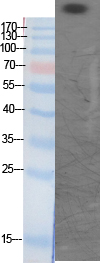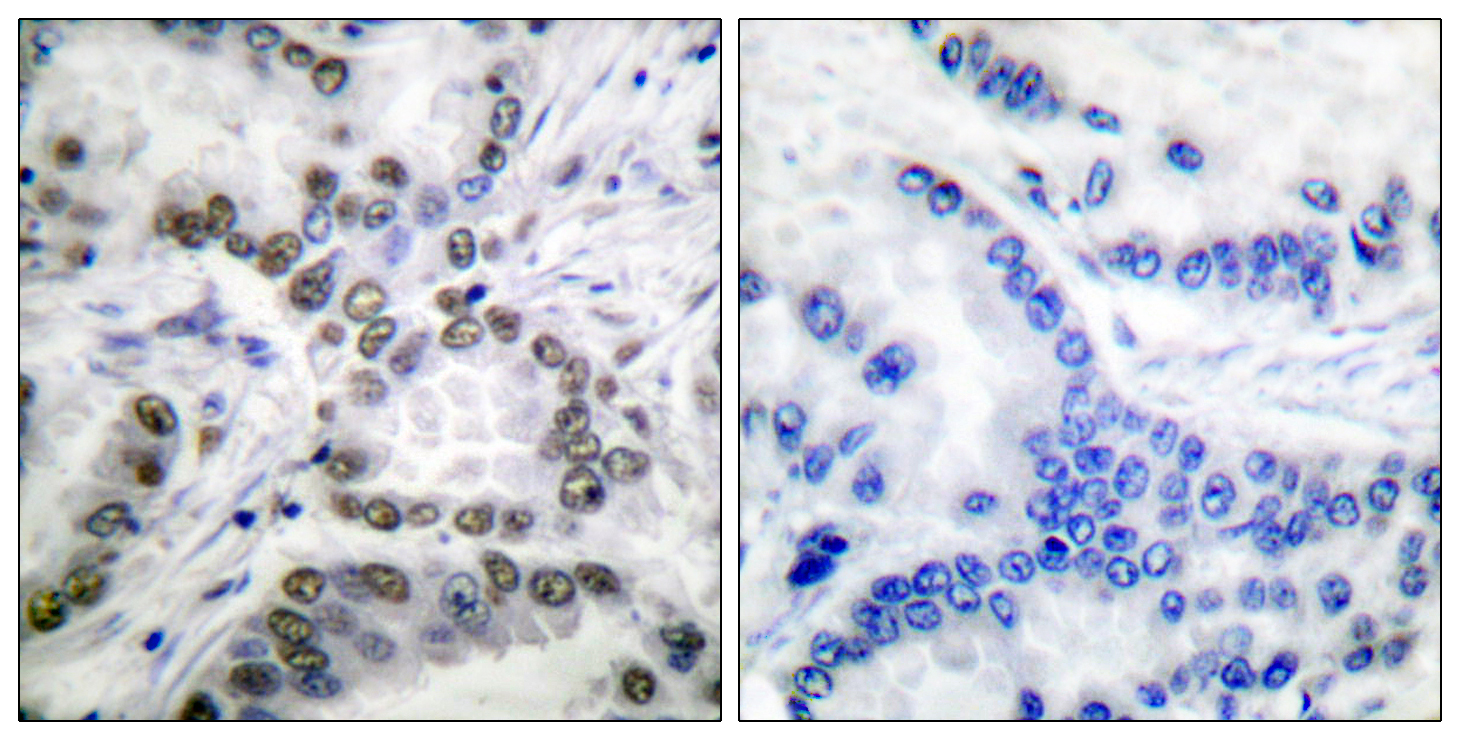CREB-BP (Acetyl Lys1535) Polyclonal Antibody
- Catalog No.:YK0019
- Applications:WB;IHC;IF;ELISA
- Reactivity:Human;Mouse;Rat
- Target:
- CBP
- Fields:
- >>Viral life cycle - HIV-1;>>cAMP signaling pathway;>>HIF-1 signaling pathway;>>FoxO signaling pathway;>>Cell cycle;>>Wnt signaling pathway;>>Notch signaling pathway;>>TGF-beta signaling pathway;>>Adherens junction;>>JAK-STAT signaling pathway;>>Long-term potentiation;>>Melanogenesis;>>Thyroid hormone signaling pathway;>>Glucagon signaling pathway;>>Growth hormone synthesis, secretion and action;>>Huntington disease;>>Tuberculosis;>>Hepatitis B;>>Influenza A;>>Human papillomavirus infection;>>Human T-cell leukemia virus 1 infection;>>Kaposi sarcoma-associated herpesvirus infection;>>Pathways in cancer;>>Viral carcinogenesis;>>MicroRNAs in cancer;>>Renal cell carcinoma;>>Prostate cancer
- Gene Name:
- CREBBP
- Protein Name:
- CREB-binding protein
- Human Gene Id:
- 1387
- Human Swiss Prot No:
- Q92793
- Mouse Swiss Prot No:
- P45481
- Rat Swiss Prot No:
- Q6JHU9
- Immunogen:
- The antiserum was produced against synthesized peptide derived from human CBP around the acetylated site of Lys1535. AA range:1501-1550
- Specificity:
- Acetyl-CBP (K1535) Polyclonal Antibody detects endogenous levels of CBP protein only when acetylated at K1535.
- Formulation:
- Liquid in PBS containing 50% glycerol, 0.5% BSA and 0.02% sodium azide.
- Source:
- Polyclonal, Rabbit,IgG
- Dilution:
- WB 1:500 - 1:2000. IHC 1:100 - 1:300. ELISA: 1:20000.. IF 1:50-200
- Purification:
- The antibody was affinity-purified from rabbit antiserum by affinity-chromatography using epitope-specific immunogen.
- Concentration:
- 1 mg/ml
- Storage Stability:
- -15°C to -25°C/1 year(Do not lower than -25°C)
- Other Name:
- CREBBP;CBP;CREB-binding protein
- Observed Band(KD):
- 265kD
- Background:
- This gene is ubiquitously expressed and is involved in the transcriptional coactivation of many different transcription factors. First isolated as a nuclear protein that binds to cAMP-response element binding protein (CREB), this gene is now known to play critical roles in embryonic development, growth control, and homeostasis by coupling chromatin remodeling to transcription factor recognition. The protein encoded by this gene has intrinsic histone acetyltransferase activity and also acts as a scaffold to stabilize additional protein interactions with the transcription complex. This protein acetylates both histone and non-histone proteins. This protein shares regions of very high sequence similarity with protein p300 in its bromodomain, cysteine-histidine-rich regions, and histone acetyltransferase domain. Mutations in this gene cause Rubinstein-Taybi syndrome (RTS). Chromosomal translocations invo
- Function:
- catalytic activity:Acetyl-CoA + histone = CoA + acetylhistone.,disease:Chromosomal aberrations involving CREBBP may be a cause of acute myeloid leukemias. Translocation t(8;16)(p11;p13) with MYST3/MOZ; translocation t(11;16)(q23;p13.3) with MLL/HRX; translocation t(10;16)(q22;p13) with MYST4/MORF. MYST3-CREBBP may induce leukemia by inhibiting RUNX1-mediated transcription.,disease:Defects in CREBBP are a cause of Rubinstein-Taybi syndrome (RSTS) [MIM:180849]. RSTS is an autosomal dominant disorder characterized by craniofacial abnormalities, broad thumbs, broad big toes, mental retardation and a propensity for development of malignancies.,domain:The KIX domain mediates binding to HIV-1 Tat.,function:Acetylates histones, giving a specific tag for transcriptional activation. Also acetylates non-histone proteins, like NCOA3 coactivator. Binds specifically to phosphorylated CREB and enhances
- Subcellular Location:
- Cytoplasm. Nucleus. Recruited to nuclear bodies by SS18L1/CREST. In the presence of ALX1 relocalizes from the cytoplasm to the nucleus.
- Expression:
- Acute myeloid leukemia,Brain,Epithelium,
- June 19-2018
- WESTERN IMMUNOBLOTTING PROTOCOL
- June 19-2018
- IMMUNOHISTOCHEMISTRY-PARAFFIN PROTOCOL
- June 19-2018
- IMMUNOFLUORESCENCE PROTOCOL
- September 08-2020
- FLOW-CYTOMEYRT-PROTOCOL
- May 20-2022
- Cell-Based ELISA│解您多样本WB检测之困扰
- July 13-2018
- CELL-BASED-ELISA-PROTOCOL-FOR-ACETYL-PROTEIN
- July 13-2018
- CELL-BASED-ELISA-PROTOCOL-FOR-PHOSPHO-PROTEIN
- July 13-2018
- Antibody-FAQs
- Products Images

- Western Blot analysis of MCF-7 cells using Acetyl-CBP (K1535) Polyclonal Antibody diluted at 1:1000. Secondary antibody(catalog#:RS0002) was diluted at 1:20000

- Immunohistochemistry analysis of paraffin-embedded human lung carcinoma tissue, using CBP (Acetyl-Lys1535) Antibody. The picture on the right is blocked with the synthesized peptide.



